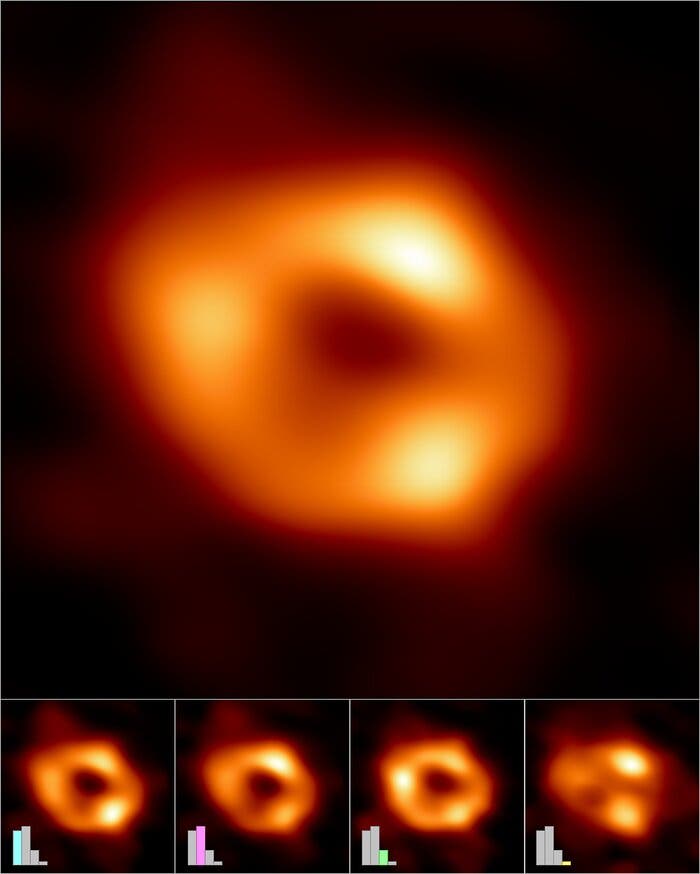The supermassive black hole that dwells at the centre of the Milky Way–Sagittarius A* (Sgr A*)–has been imaged by humanity for the first time proving beyond doubt this compact radio object is indeed a black hole.
The image of the black hole at the heart of our galaxy was captured by the Event Horizon Telescope (EHT), which made history in 2019 when it produced the first-ever image of a black hole–the supermassive black hole at the heart of the galaxy Messier 87 (M87).
In a press conference discussing the new historic image, Sera Markoff of the University of Netherlands said: “This is the first image of the supermassive black hole at the heart of our Milky Way galaxy, Sagittarius A*.
“For decades we have known about a compact object that is at the heart of our galaxy that is 4 million times more massive than our Sun. Today, right at this moment, we have direct evidence that this object is a black hole.”
Markoff went on to explain: “The black hole resides inside the dark region at the centre of this image where its gravitational pull is so strong the light cannot escape and only darkness remains.
“We call this region the shadow of the black hole.”
The new findings also confirm the black hole in the direction of the constellation of Sagittarius and 27,000 light-years away from our solar system is spinning and that this supermassive black hole is facing Earth head-on.

The EHT team’s results are being published today in a special issue of The Astrophysical Journal Letters.
What We Are Seeing in the Sgr A* Image
Black holes are surrounded by surfaces called event horizons–the point at which their tremendous gravity is so great that not even light moves fast enough to escape it. Thus, the event horizon marks the last point around a black hole that a telescope could see or image.
Because black holes don’t emit light, the aim of the EHT is to collect direct images of black holes like M87 and Sgr A* by observing their “shadow” or “silhouette” caused by the bending of light under extreme gravity.
So what we are seeing in this new image is the event horizon of Sgr A*–believed to extend out to around 6 million kilometres, about 15 times the distance between the Earth and the moon–and the area surrounding that limit.
As well as being the location of this supermassive black hole, the central region of the Milky Way is also home to around 10 million stars with researchers having learned much about Sgr A* from the stars that orbit closely to it, particularly the star S2.
This observation further confirms the predictions made in Einstein’s 1915 theory of gravity in which the existence of black holes was first predicted. EHT Project Scientist Geoffrey Bower from the Institute of Astronomy and Astrophysics said: “We were stunned by how well the size of the ring agreed with predictions from Einstein’s Theory of General Relativity.”
Comparing Sgr A* to M87’s Supermassive Black Hole
Sgr A* is much smaller than the supermassive black hole of M87, millions of times the mass of the sun rather than billions like M87’s central black hole. Sgr A* also gobbles matter around it at a much slower rate. Markoff compared this to a human being whose diet consists of “one grain of rice every million years.”
M87’s supermassive black hole consumes matter rapidly, launching powerful astrophysical jets as it does so, something yet to be seen from Sgr A*. This isn’t the reason M87’s supermassive was imaged first, however, despite being much farther away from Earth–55 million light-years rather than 27,000 light-years.
Imaging Sgr A* directly has been complicated by matter like gas and dust in the Milky Way obscuring our view of its central supermassive black hole, as well as by scattering radio waves coming from the region around the black hole.
But this wasn’t the biggest challenge in imaging Sgr A*. The gas around both imaged black holes moves at nearly the speed of light, but because Sgr A* is so small its gas orbits rapidly making it challenging to catch an image of it.

The EHT collaboration points out that matter orbiting the black hole should have an innermost stable circular orbit which corresponds to a time of 4 minutes to 30 minutes. That means any variations in the gas emission around the very centre may change at these time scales– much shorter than a regular EHT observing night, which takes several hours.
That means catching an image like this is only possible with a very sharp image of the black hole in the microwave region of the spectrum.
To achieve this the EHT collaboration brings together telescopes from across the globe, virtually uniting them and creating one giant single telescope as big as the planet. This means taking signals from the individual telescopes–placed at high altitudes with a dry atmosphere thus avoiding the effect of water vapour–combining them to create a single image.
“To interpret the image and to learn more about black holes we perform detailed models of how the gas and the light behave in the direct vicinity of black holes,” Havard University’s Christian M. Fromm said. “Our models have four ingredients, the black hole, magnetic fields, gas circulating the black hole and the light emitted by the gas which is finally collected by the telescopes of the EHT.”
The model, which also considered in-falling matter, showed black hole is rotating and is “face on” in orientation to Earth. Mariafellicia de Laurentis, part of the EHT team, said Sgr A* will be a testbed for examining gravitational physics in greater detail.
“These measurements of opening a new window or to studying black holes, and their central role in our universe,” de Laurentis said. The years ahead, of course, will transform our understanding of black holes and the fundamental nature of gravity.
“So stay tuned because the best is yet to come.”


